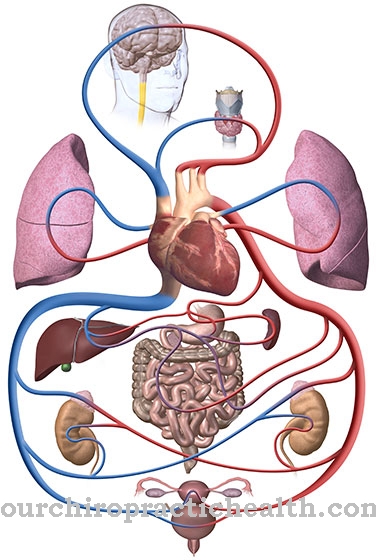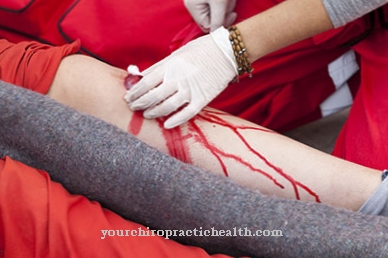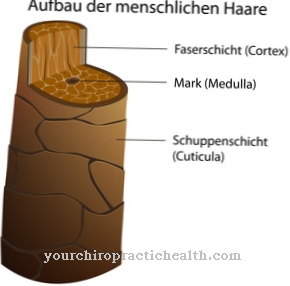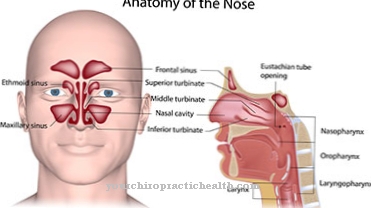As Vestibular neuritis Doctors describe a dysfunction of the organ of equilibrium. Those affected suffer from vertigo.
What is vestibular neuritis?

© Henrie - stock.adobe.com
In medicine it is Vestibular neuritis also as Vestibular neuropathy known. What is meant is an acute or chronic disturbance of the function of the organ of equilibrium, which is located in the inner ear. Other names for the disease are Vestibulopathy, Vestibular neuropathy such as Vestibular neuronitis.
Neuronitis means "inflammation of the nerves". Sometimes the condition is also called "acute hearing loss of the balance organ". The incidence of vestibular neuritis is 3.5 in 100,000 per year. The proportion of diagnoses in specialist clinics for vertigo is around seven percent.
The vestibular neuropathy is one of the three most common forms of vertigo. In most cases, vertigo occurs between the ages of 30 and 60. In addition, vestibulopathy often shows up in spring or early summer.
causes
It is still unclear what causes the vestibular neuritis can be considered. It is believed that viruses are responsible for causing the disease. It is not uncommon for viral infections to appear before the onset of vestibular neuropathy. However, circulatory disorders can also be the trigger for dizziness.
These cause functional disorders or even a functional failure of the balance organ on the side of the body that is affected by the disease. While the brain of the affected person still receives normal signals on the healthy side, on the diseased side there is no or only a disturbed signal. Due to this imbalance, the patient suffers from severe attacks of dizziness in the initial stage. Herpes infections, Lyme borreliosis and autoimmune diseases are suspected to be other rare causes.
Symptoms, ailments & signs
A typical symptom of vestibular neuritis is severe vertigo. This is usually accompanied by nausea and vomiting. The general well-being of the patient also suffers from the disease. It is not uncommon for the dizziness to be so severe that the person affected is unable to walk without help.
In some cases the symptoms improve when the patient lies down quietly on their back and closes their eyes. However, if even slight movements are made, the condition worsens again. The symptoms of vestibular neuritis usually last for a few days. However, as you progress, they gradually get better.
Another side effect of vestibular neuropathy is nystagmus, which causes jerky eye movements. The eyes move in the direction of the nerves of the balance organ that are not affected by the disease. A tendency to fall to the diseased side while standing or sitting is also typical. Usually the hearing of the patient is not impaired in vestibular neuritis.
Diagnosis & course of disease
If vestibular neuritis is suspected, a doctor should be consulted. This first deals with the anamnesis (medical history) of the patient and lets him describe the symptoms. Possible previous illnesses are also of interest.
The nystagmus of the eyes also plays an important role. To check this, the patient puts on special Frenzel glasses. The next step is to do a vestibular test to check balance. The ear canal is exposed to a warm irrigation. This procedure also checks the eyes. People who suffer from vestibular neuritis show no changes in the direction of the nystagmus.
Special ear, nose and throat medical examinations or diagnostic imaging procedures can also be useful. These include sonography (ultrasound examination), computed tomography (CT) or magnetic resonance imaging (MRI). The ear, nose and throat doctor makes the diagnosis by checking the calories of the inner ear.
This leads to a thermal underexcitability in the organ of equilibrium, which occurs through warm or cold water or air. As dizziness attacks can also have numerous other causes, it is particularly important to differentiate them if vestibular neuritis is suspected. The possible diseases can be Meniere's disease or benign positional vertigo.
Vestibular neuritis usually takes a positive course. In most patients, for example, the sense of balance is restored or at least improved after a period of about twelve weeks. However, around 15 percent of all those affected also suffer from benign positional vertigo.
When should you go to the doctor?
Unsteady gait and an increased occurrence of accidents or falls are signs of an existing irregularity. You should be presented to a doctor so that serious damage can be avoided. A doctor is needed in the event of dizziness, nausea and vomiting. What is known as vertigo, which makes it impossible to walk straight ahead, is characteristic. A doctor should be consulted if the body is tilted when moving, if the movement is unsteady or if the overall appearance is very unstable. If bystanders notice unusual eye movements by the person concerned, this should be discussed with a doctor.
A temporary spontaneous healing is characteristic of vestibular neuritis. This occurs as soon as the person concerned allows himself to rest on his back and closes his eyes. At the same time, the symptoms increase in intensity as soon as light movements are performed. If help is needed with locomotion, everyday obligations can no longer be accomplished alone or if hearing impairment occurs, a doctor should be consulted.
Often there is a feeling of pressure in the ear, ringing in the ears or certain frequencies can no longer be heard as usual. A tendency of the person concerned to fall while sitting or standing is considered unusual. It should be clarified by a doctor so that the cause of the symptoms can be diagnosed and treatment can be initiated.
Treatment & Therapy
Occasionally, vestibular neuritis may require the affected person to be treated as an in-patient in a hospital. Patients have to stay in bed for a certain period of time. They are given appropriate medication to treat symptoms such as dizziness, vomiting, and nausea.
Several infusions are given to improve blood circulation. These are also helpful in replacing fluids lost through vomiting. The glucocorticoid methylprednisolone is a tried and tested drug. Treatment with the substance takes about a week. As the therapy progresses, the dose is gradually reduced to restore the equilibrium nerve.
If the disorder does not improve again after a short time, training measures take place in which the patient learns how to deal with his complaints. The focus is on intensive balance training. It is used to speed up the healing process. To this end, the doctor exposes the equilibrium system under controlled conditions to situations that lead to dizziness. The stimulus can promote recovery.
Complications
As a rule, the prognosis for vestibular neuritis is favorable. Serious complications are rare. Usually the dizziness is over after about three months. In rare cases, however, recurrences can occur, which then affect the other ear. Furthermore, about 15 percent of all patients experience benign positional vertigo in the same ear.
This can also be treated well and is only a temporary phenomenon. However, it becomes more complicated for those affected who experience vertigo caused by illness as a traumatic event. In these cases, a phobic postural vertigo can also develop. Since this cannot be traced back to organic causes, but exclusively to psychological causes, the therapy here must focus on eliminating the anxiety disorder.
A potentially serious complication of vertigo can be triggered by a dangerous fall, which is often associated with serious injuries and broken bones. This risk particularly affects older people, whose bone stability has already been additionally reduced by osteoporosis. A chronic bilateral labyrinth failure occurs very rarely in vestibular neuritis.
Standing and walking motor skills are disturbed in the dark or in closed eyes. In the long term, this double burden on both ears often leads to complete disorientation in the room. It is then no longer possible to practice dangerous professions or high-risk sports.
You can find your medication here
➔ Medicines for balance disorders and dizzinessOutlook & forecast
The course and prognosis of vestibular neuritis are favorable. Most of the time, spontaneous healing occurs within two to three weeks. In the majority of those affected, the sense of balance normalizes completely or at least partially after 12 weeks at the latest. However, some of those affected still have dizziness after several months.
In rare cases, dizziness changes into other forms of dizziness or imbalance. So-called benign paroxysmal positional vertigo (benign positional vertigo) also appears in the affected ear in up to 15 percent of those affected. This is characterized by short attacks of vertigo when moving or changing position of the head (looking down or up, turning the head) or when lying down. The persistent vertigo can also traumatize the affected person to such an extent that fearful expectations of a possible vertigo attack develop into a phobic vertigo.
The individual prognosis depends primarily on the person concerned being physically activated again as quickly as possible. The general condition is also important for the prognosis. Older people often suffer longer from the existing symptoms due to their comparatively poor general condition. Recurrences (recurrence of dizziness) only occur in very rare cases and then usually affect the previously unaffected ear.
prevention
There are no known preventive measures against vestibular neuritis. So the causes of vertigo are still in the dark.
Aftercare
In most cases of vestibular neuritis, the patient has very few and limited options for direct follow-up care. The person affected should therefore ideally consult a doctor at an early stage and initiate treatment in order to prevent further complications and complaints from occurring. It cannot heal on its own, so medical treatment is always necessary.
Most patients typically rely on various medications to be taken. The person concerned should follow all the doctor's instructions and take the medication regularly and in the correct dosage. If you have any questions or if anything is unclear, you should always consult a doctor first.
Furthermore, in many cases, the affected person's support from his or her own family is necessary. Those affected should drink a lot to relieve the symptoms. The medication itself can be slowly discontinued after consulting a doctor. Often, contact with other sufferers of vestibular neuritis can also be very useful, as this leads to an exchange of information, which can make the patient's everyday life much easier.
You can do that yourself
After a clear diagnosis of vestibular neuritis, everyday and self-help measures can improve the way you deal with the disease and shorten the healing process. Regardless of whether the disease is due to circulatory disorders in the vestibular organs or other underlying factors, practical exercises are useful in addition to drug treatment. They also serve the immediate encounter and relief of dizziness attacks and feelings of nausea.
To overcome nystagmus, the choppy involuntary eye movement. For example, it helps to sit upright on a chair and move your hand to the right and left with your finger outstretched at a distance of 30 cm to 50 cm. The eyes should follow the hand or finger without turning their head. Through the exercise, the involuntary eye movement (nystagmus) is superimposed by a deliberately executed eye movement and weakens the nystagmus.
Other exercises that are performed regularly, usually for strengthening the vestibular organs, also help overcome the nausea caused by vestibular neuritis. Specifically, these are exercises such as “standing on one leg”, “walking in a line” or “walking sideways and backwards”. The blood circulation is promoted by physical exercise. Combinations of movement and training of balance, such as dancing, are particularly effective.


.jpg)

.jpg)






















